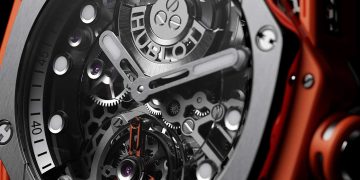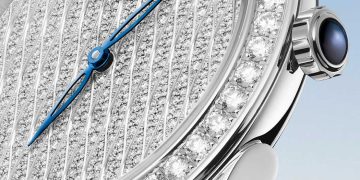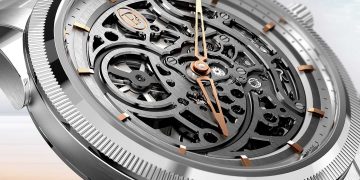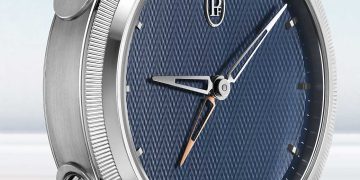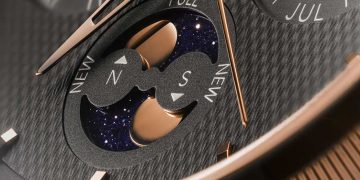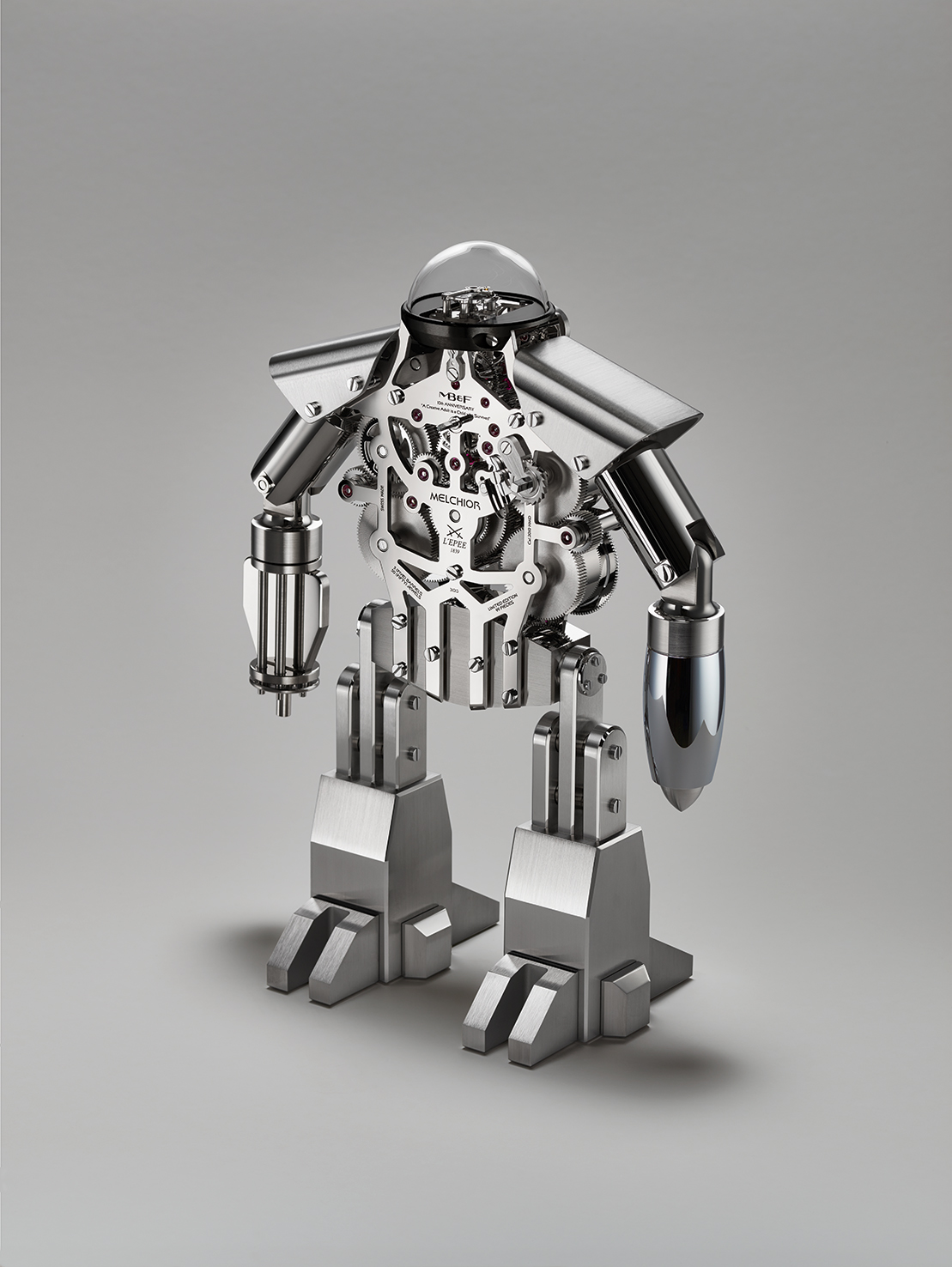
Founded in 2005, MB&F celebrates its first decade in 2015; to commemorate this milestone, the Geneva-based Horological lab will present a number of Anniversary Pieces during the year, under the theme: ”A creative adult is a child who survived”. The first piece is Melchior, created with L’Epée 1839: an impressive kinetic robot which may remind you of your childhood dreams, but also happens to be an impeccably finished, 480-component mechanical table clock.
Indeed, with his smart steel and brass armour, enigmatic glint in his eyes, animated brain and muscular, articulated arms – the right one packing a rocket launcher, the left a Gatling gun – Melchior is the robot buddy you would want by your side while trying to thwart Darth Vader. But look again and you will see Melchior is a majestic high-end table clock featuring jumping hours, sweeping minutes, double retrograde seconds and a 40-day power reserve; a tribute to refined, classic clock- and watchmaking.
Conceived and developed by concept lab MB&F, and engineered and crafted by L’Epée 1839 – Switzerland’s only specialised high-end clock manufacture – Melchior is the result of Maximilian Büsser’s quest to revisit his childhood hankering for a robot friend.
“A long time ago in a galaxy far, far away, man’s best friend was his robot,” says Büsser. “As a 10-year-old fan of Star Wars, I knew Luke Skywalker could never have prevailed had it not been for droids like R2-D2 – a loyal, resourceful and brave robot who was always saving his friends. As an only child, I imagined having my own robot companion… Melchior makes that childhood fantasy a reality.”
Christening this roboclock ‘Melchior’ – after a traditional forename in his family – Büsser developed the concept with designer Xin Wang, selecting a high-end L’Epée clock movement and reimagining it as the mechanical head and torso of a robot. Jumping hours and sweeping minutes on Melchior’s chest are displayed via discs bearing MB&F’s signature numerals – with pointers incorporated into the breastplate – while a dial on Melchior’s abdomen is the power reserve indicator. And this robot’s self-sufficiency is to be admired, for the finely-finished, highly-visible movement boasts a power reserve of 40 days – for most table clocks, it is eight days – thanks to five main spring barrels which help make up Melchior’s rippling torso. The barrels are in series for optimal performance.
The retrograde action of Melchior’s expressive eyes marks off intervals of 20 seconds. A combination of fixed vents and revolving discs, both bearing radial propeller motifs, gives the impression that Melchior is closing and opening his eyes – the resulting blinking effect endows the robot with a hint of endearing human-like personality.
Further animation is provided by the regulator, its gentle beating and intricate composition made visible thanks to its polished glass dome cover. If the protective dome acts like a skull, then the regulator symbolises Melchior’s brain at work; just as the brain governs the body, the regulator governs the clock’s remarkable precision.
A true robot companion is one you can play with and Melchior doesn’t disappoint. His steel upper arms rotate and his lower arms pivot up or down – excellent manoeuvrability for aiming his rocket launcher or Gatling gun to blast away the bad guys. And in a neat design touch, his gun detaches and doubles as the winding/setting key for the movement.
Melchior is limited to 99 pieces and is available in a monochromatic ‘light’ edition or a two-tone ‘dark and light’ edition featuring black PVD-treated components.
Melchior in detail
Melchior – a robot-cum-table clock
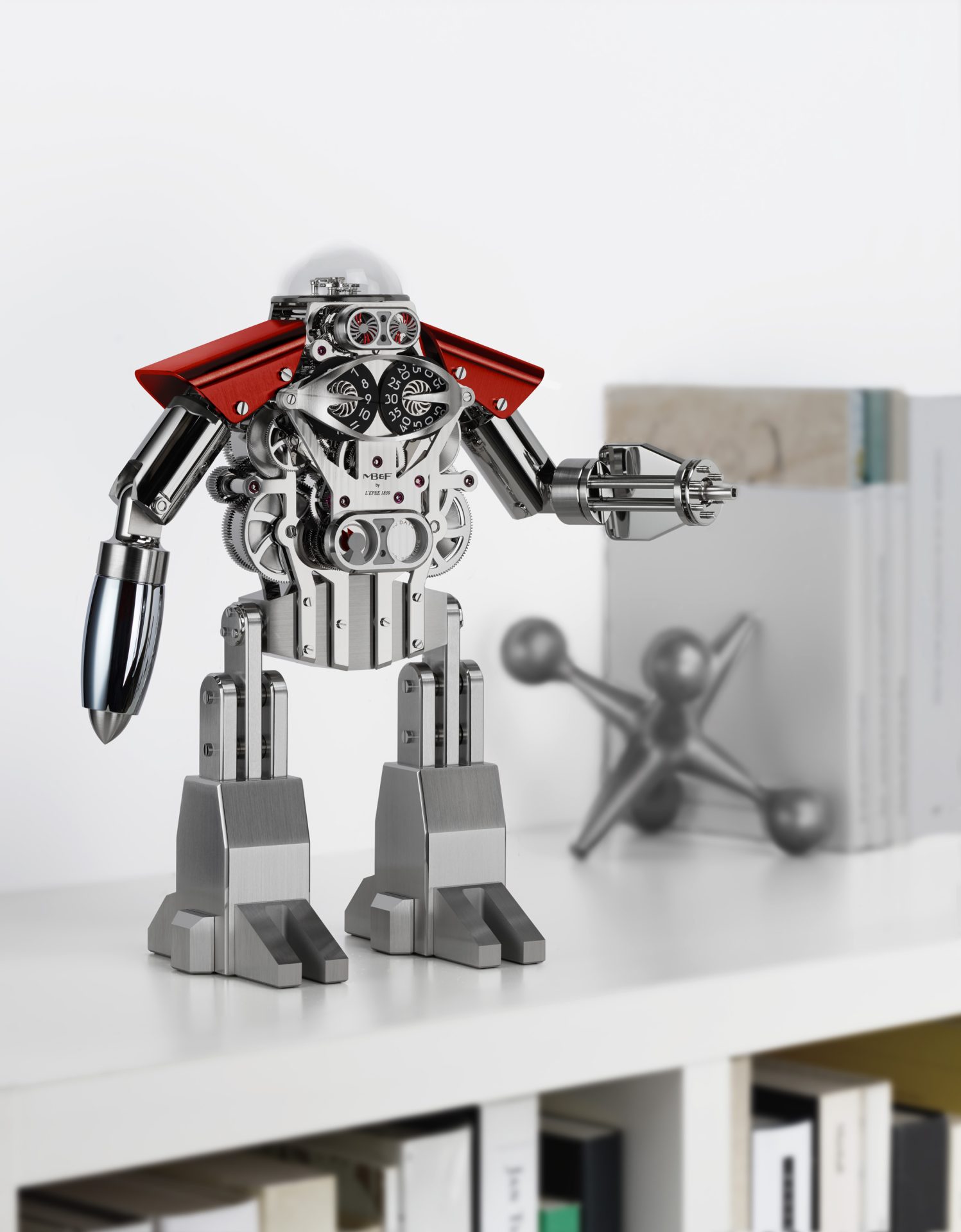
Melchior comprises no fewer than 480 components, each one machined and finished at L’Epée’s Swiss atelier, bar the 50 movement jewels. An impressive 334 components make up the movement, while another 146 pieces comprise Melchior’s bodywork and armour. Such was the originality of MB&F’s robot concept that L’Epée needed to develop several new components: Machining, finishing and assembling a piece like the bulging glass dome forming Melchior’s skull was a first for L’Epée, as was crafting a stainless steel winding/time-setting key to resemble a Gatling gun.
The winding/time-setting key clips into Melchior’s left elbow joint socket. It is held by a small magnet strong enough to hold the key, but not so powerful as to affect the function of the movement. The key boasts a double-depth square socket that neatly fits over both of the square pegs on the back of Melchior. One of the pegs is for winding the movement, the other for time-setting.
Working from MB&F’s design, L’Epée diligently developed the various bodywork and armour components, carefully choosing materials according to the properties required. Where precision was critical – Melchior’s kinetic parts or his precision rocket launcher, for instance – plated brass was selected. His armour on the other hand is crafted mainly in stainless steel, providing optimal resistance to withstand any enemy attacks. And for the finishing touch, L’Epée have applied a range of eye-catching finishes to Melchior’s bodywork – including anglage, mirror polishing, satin finishing, circular satin finishing, sand-blasting and polishing.
“L’Epée are amazing, a joy to work with,” says Maximilian Büsser. “They always step up to the plate, no matter how original, how challenging the design”.
For L’Epée CEO Arnaud Nicolas, the positive feeling is mutual. “We had a real blast making Melchior with MB&F,” he says. “Melchior is not just a table clock, it is a kinetic sculpture for eternal children and includes lots of small details, the type that we love working on at L’Epée. It was a stimulating technical challenge”.
Arnaud Nicolas adds: “There is a real majesty about Melchior. When we first saw the plans for it, we knew it was going to be good. But only after making the first prototype did we realise quite how special it was going to be. On that day we knew MB&F’s creativity had pushed us once again to a place no one had gone before…”
Melchior’s movement in focus
To create Melchior’s highly visible movement, L’Epée developed a completely new skeletonised mainplate, in palladium-plated brass, which sandwiches the movement mechanism, also in palladium-plated brass. This mainplate – which forms the ribcage, breastplate, cheekbones and backbones of the robot – is black PVD-treated for the ‘dark-and-light’ edition of Melchior.
For clear reading of the hour, L’Epée developed a ‘slow’ jumping hour. This in-house complication sees the hour disc remain static for 55 minutes, then start to turn five minutes before the new hour so that the change of hour is smooth and subtle.
The movement regulator features an Incabloc shock protection system, which minimises the risk of damage when the clock is being transported. This sort of shock protection is generally only seen in wristwatches. In fact, Melchior’s exclusive table clock movement features the same type of mechanisms as a wristwatch – gear train, mainspring barrel (here five, in series), balance wheel, escape wheel and anchor – but their dimensions are far larger.
The movement also features superlative fine finishing – Côtes de Genève, anglage, polishing, sand-blasting, circular and vertical satin finishing – that is seen on a wristwatch. However, finely finishing a clock movement is far more challenging than finishing a wristwatch because of the greater surface areas of the larger components. L’Epée CEO Arnaud Nicolas explains: “It’s not simply a case of double the size of the components, double the time it takes to finish them. The complexity increases exponentially. For polishing, for example, you need to apply the same pressure as when finishing a watch movement but on a bigger surface. Any variation in that pressure will show up in the finishing, so a skilled and steady hand is required to apply uniform pressure.”
The name ‘Melchior’
Fictional robots often possess monikers sounding like acronyms or reference numbers – think of HAL 9000, C-3PO or K-9. But Max Büsser was eager to christen this one ‘Melchior’.
He explains: “In the Büsser family, for over five centuries from the 1400s onwards, every eldest Büsser son was either called Melchior or Balthazar. It alternated. My grandfather was called Melchior and hated it, so he had everybody call him Max, which is how I became a Max. My grandfather hated the Melchior-Balthazar thing so much that he put an end to this 500-year-old tradition by calling my father Mario… Now, a century later, I happen to love the name Melchior!”
Melchior: Technical Specifications
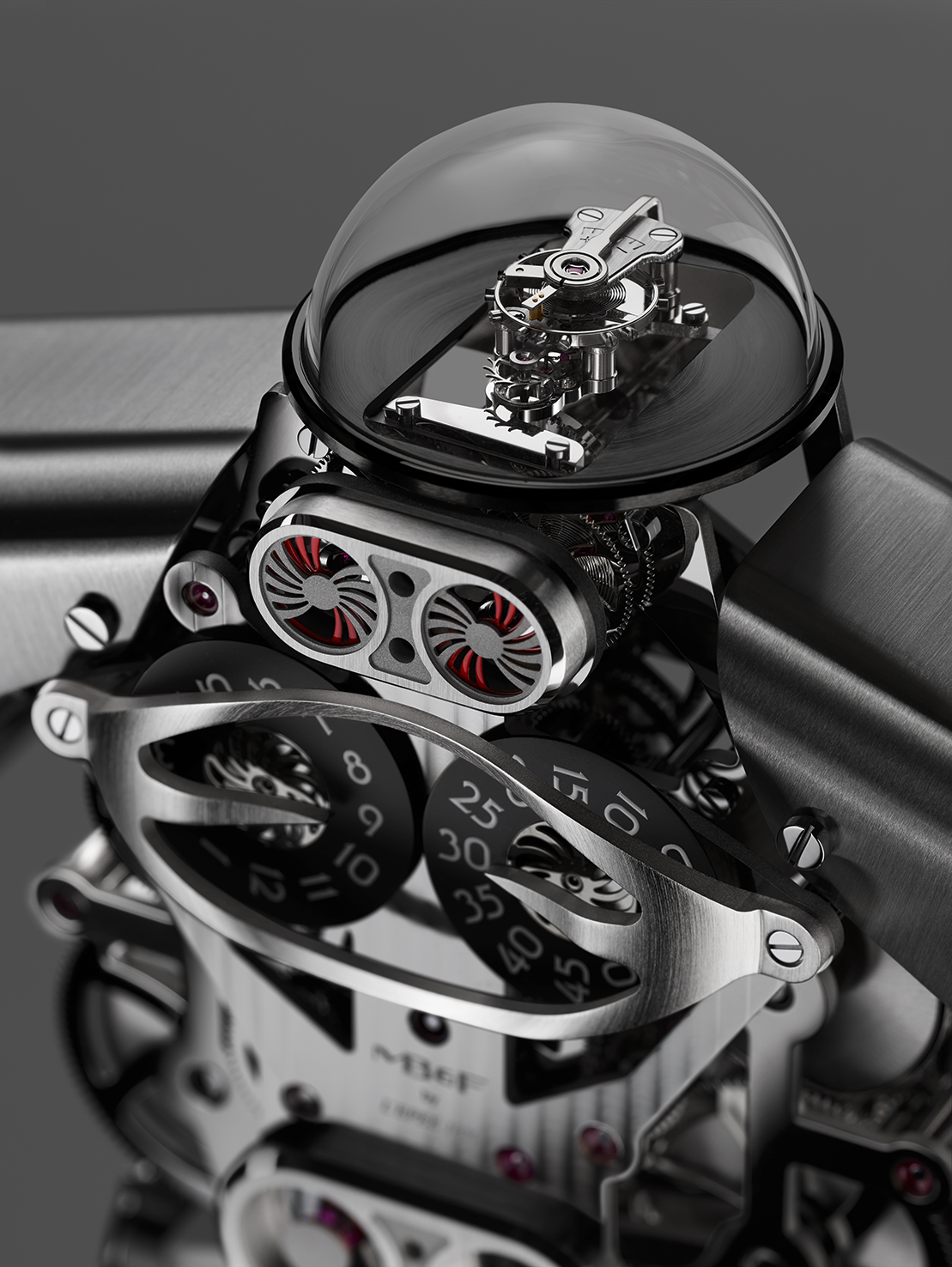
Melchior is limited to 99 pieces and is available in a monochromatic ‘light’ edition or a two-tone ‘dark and light’ edition, the latter featuring black PVD-treated components.
Display
Jumping hours and sweeping minutes: Twin discs forming part of Melchior’s breast plate, one disc displaying hours, the other disc minutes, both featuring MB&F’s signature numerals.
Retrograde seconds: Flyback discs mark 20-second intervals behind a steel mask
Power reserve indicator: Dial on abdomen providing intuitive view of remaining energy
Movement
L’Epée in-house designed and manufactured movement
Balance frequency: 18,000 bph / 2.5Hz
Barrels: 5 in series
Power reserve: 40 days
Movement components: 334
Jewels: 50
Incabloc shock protection system
Mechanism in palladium-plated brass
Manual-winding: double-depth square socket key sets time and winds movement
Movement finishing: includes Côtes de Genève, anglage, polishing, sand-blasting, circular and vertical satin finishing
Melchior’s body and armour
Dimensions: 30.3cm x 21.7cm (depending on position of the arms) x 11.2cm
Weight: 6.3kg
Body/armour components: 146
Head
Dome: polished glass screwed via polished and bevelled palladium-plated brass bezel
Retrograde seconds display in stainless steel
Movement mainplate in palladium-plated brass
Torso
Breastplate (forming hour and minute hands) in palladium-plated brass
Abdomen (power reserve indicator frame) in stainless steel
Ribcage/spine (formed by skeletonised mainplate) in palladium-plated brass
Legs
Pelvis, thighs, shins and feet in stainless steel
Hips (long central bars joining pelvis) in stainless steel
Shoulders and arms
Shoulders, upper arms and lower arm sockets in stainless steel; magnet in left arm socket
Right forearm: screwed-in rocket with chrome-plated brass body and stainless steel warhead
Left forearm: Gatling gun/detachable stainless steel winding key with palladium-plated brass
Body and armour finishing includes anglage, mirror polishing, satin finishing, circular satin finishing, sand-blasting, polishing. ‘Shoulders’, ‘pelvis’ and skeletonised mainplate treated with black PVD for the two-tone ‘dark and light’ edition of Melchior.
MB&F – award-winning concept laboratory
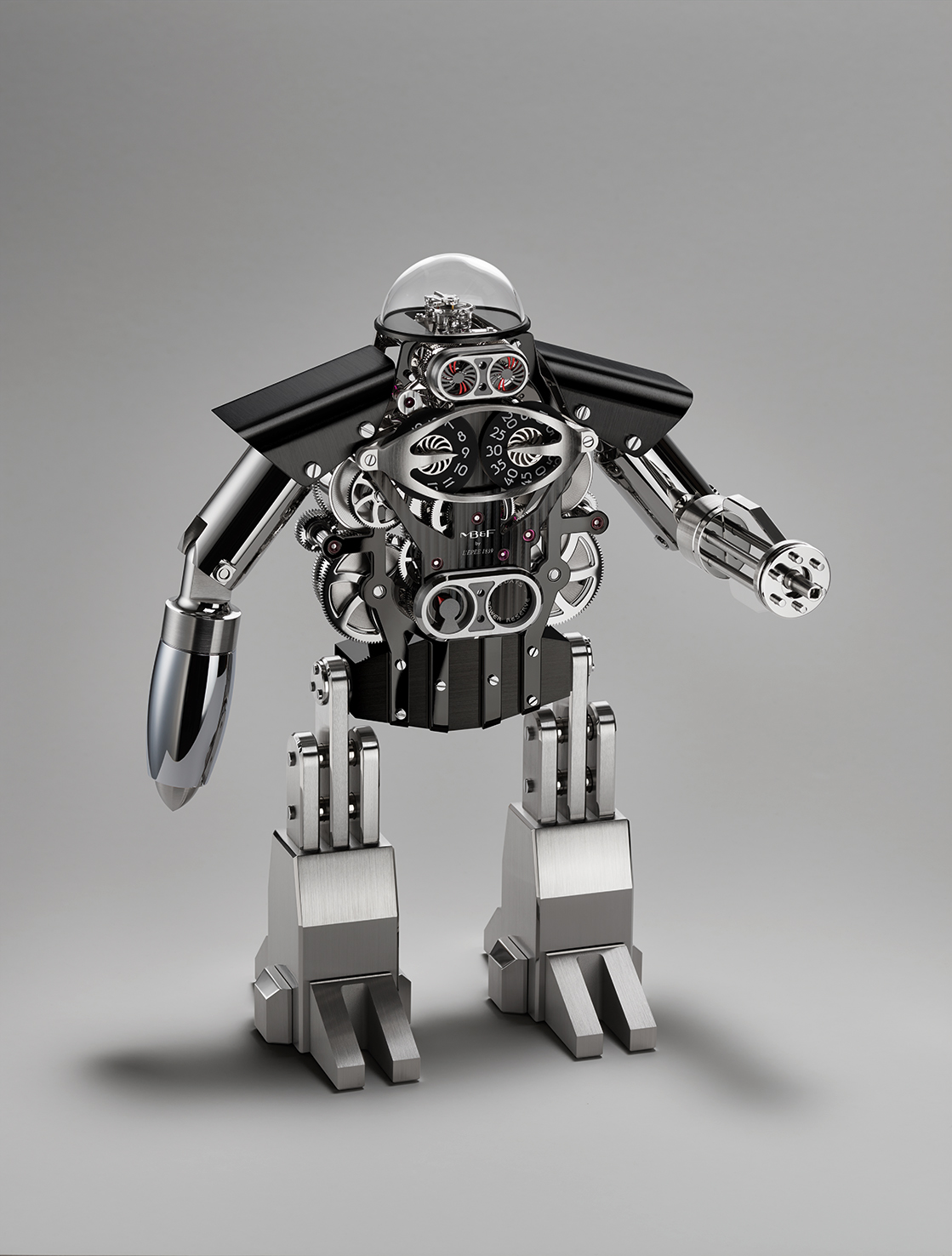
In 2005, after seven years in the senior management team of Jaeger-LeCoultre and another seven years as managing director of Harry Winston Rare Timepieces in Geneva, Maximilian Büsser created the world’s first horological concept brand: MB&F – Maximilian Büsser & Friends. MB&F is dedicated to developing radical horological concepts by working in small, hyper-creative groups composed of people Büsser enjoys working with. Respecting tradition without being shackled by it enables MB&F to act as a catalyst in fusing traditional, high-quality watchmaking with cutting-edge technology to create three-dimensional mechanical sculptures.
In 2007, MB&F unveiled their first Horological Machine. Its sculptured, three-dimensional case and beautifully finished Engine set the standard for the idiosyncratic Machines that followed – Machines that tell the time, rather than Machines to tell the time. In 2011, MB&F launched their round-cased Legacy Machine collection. These more classical pieces (classical for MB&F that is) pay tribute to 19th century watchmaking excellence by reinterpreting complications from the great horological innovators to create contemporary objets d’art. Since 2011, MB&F alternate between launching an exciting new Horological Machine and an historically-inspired Legacy Machine.
At the Grand Prix d’Horlogerie de Genève in 2012, MB&F’s Legacy Machine No.1 was awarded the Public Prize (voted for by horology fans) and the Best Men’s Watch Prize (voted for by the jury). At the 2010 Grand Prix, MB&F won Best Concept and Design Watch for HM4.
L’EPEE 1839 – the premier clock manufacture in Switzerland
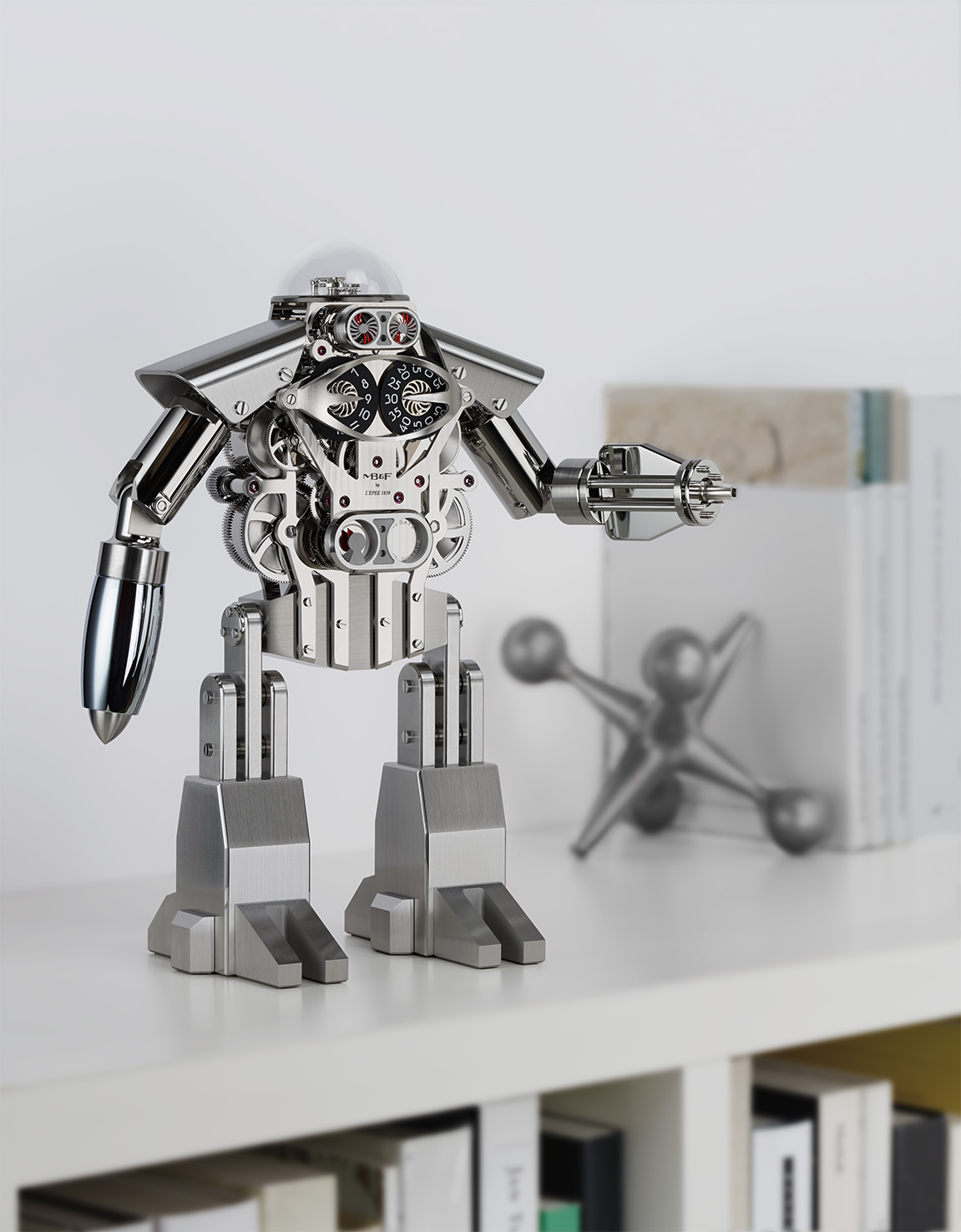
For over 175 years, L’Epée has been at the forefront of watch and clock making. Today, it is the only specialised manufacture in Switzerland dedicated to making high-end clocks. L’Epée was founded in 1839, initially to make music box and watch components, by Auguste L’Epée who set up the business near Besançon, France. The L’Epée hallmark was that all parts were made entirely by hand.
From 1850 onwards, the manufacture became a leading light in the production of ‘platform’ escapements, creating regulators especially for alarm clocks, table clocks and musical watches. By 1877, it was making 24,000 platform escapements annually. The manufacture became a well-known specialist owning a large number of patents on special escapements such as anti-knocking, auto-starting and constant-force escapements and the chief supplier of escapements to several celebrated watchmakers of the day. L’Epée has won a number of gold awards at International Exhibitions.
During the 20th century, L’Epée owed much of its reputation to its superlative carriage clocks and, for many, L’Epée was the clock of the influential and powerful; it was also the gift of choice by French government officials to elite guests. In 1976 when the Concorde supersonic aircraft entered commercial service, L’Epée wall clocks were chosen to furnish the cabins, providing passengers with visual feedback of the time. In 1994, L’Epée showed its thirst for a challenge when it built the world’s biggest clock with compensated pendulum, the Giant Regulator. At 2.2m high, it weighs 1.2 tons – the mechanical movement alone weighs 120kg – and required 2,800 man-hours of work.
L’Epée is now based in Delémont in the Swiss Jura Mountains. Under the guidance of CEO Arnaud Nicolas, L’Epée 1839 has developed an exceptional table clock collection, encompassing a range of sophisticated classic carriage clocks, contemporary design clocks (Le Duel) and avant-garde, minimalist clocks (La Tour). L’Epée clocks feature complications including retrograde seconds, power reserve indicators, perpetual calendars, tourbillons and striking mechanisms – all designed and manufactured in-house. Ultra-long power reserves have become a signature of the brand as well as superlative fine finishing.

